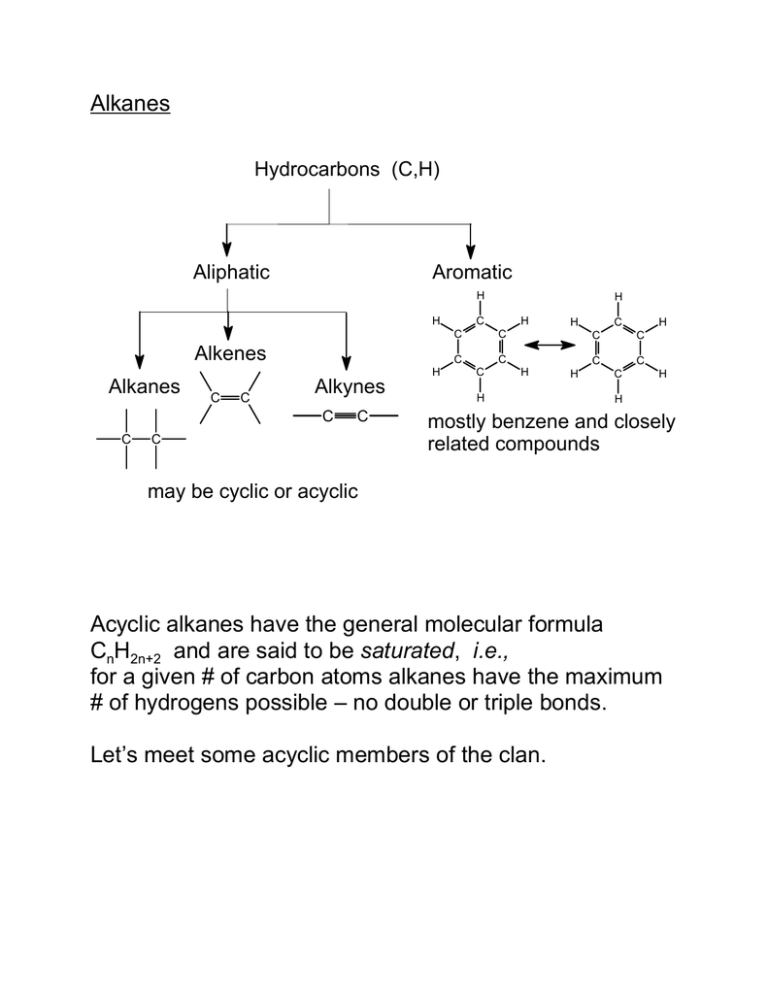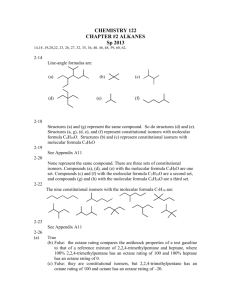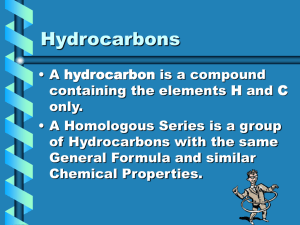Alkanes
advertisement

Alkanes Hydrocarbons (C,H) Aliphatic Aromatic H H C C Alkenes Alkanes C C Alkynes C C C C H H C C H H C C C C C H H H H C C C H H mostly benzene and closely related compounds may be cyclic or acyclic Acyclic alkanes have the general molecular formula CnH2n+2 and are said to be saturated, i.e., for a given # of carbon atoms alkanes have the maximum # of hydrogens possible – no double or triple bonds. Let’s meet some acyclic members of the clan. CH4: methane. C2H6: ethane. C3H8: propane. C4H10: the butanes; 2 constitutional isomers. C5H12: the pentanes; 3 constitutional isomers. C6H14: the hexanes; 5 constitutional isomers. C7H16: the heptanes; 9 constitutional isomers. C8H18: the octanes. C9H20: the nonanes. C10H22: the decanes; 75 constitutional isomers theoretically possible. C20H42: the eicosanes; 366,319 constitutional isomers theoretically possible (not all could be made; in some the atoms would be too close to each other for the molecule to be stable [steric hindrance]). Sources of Alkanes Not usually synthesized; isolated from natural materials. Methane — CH4 — simplest alkane — combustible gas. An end-product of the anaerobic decay of plants, found in — !"marsh gas # farts ! cattle flatulence > greenhouse gas $ natural gas ! produced by anaerobic decay of prehistoric microorganisms ! clean source of heat ! odorless # firedamp ! coal mines ! miners' (Davy) safety lamp Sources of Other Alkanes — principal source = natural gas & distillation of petroleum Fraction Distillation Temperature Number of Carbons Gas <20oC 1-4 Natural gas is mainly methane. Bottled gas is usually mainly propane; sometimes butane. Ligroin 20-100oC 5-7 Gasoline 30-200oC 5 -10* *Seasonal blend --- relatively more 5 & 6 carbon cpds. in winter, more 9 & 10 carbon cpds. in summer. Kerosine 175-325oC 12-18 Fuel Oil >275oC 12 & up Lubricating Oil non-volatile, vacuum dist. Asphalt non-volatile For gasoline "OCTANE NUMBER" is important. The higher the octane number, the less a gasoline motor will tend to "knock." Octane numbers – heptane = 0, engines knock badly; 2,2,4-trimethylpentane ("isooctane") = 100, good fuel. The octane number of a gasoline blend is the % of 2,2,4-trimethylpentane in a mixture of the above two compounds which has the same knocking properties as the gasoline; eg gasoline with a rating of 87 has the same knocking properties as a mixture which is 87% 2,2,4-trimethylpentane and 13% heptane. The octane rating of a gasoline is improved by— 1) Reforming – Pt, heat Aliphatic >More highly branched aliphatic + Aromatic. 2) Cracking – breaks larger molecules into gasoline size, mostly branched. 3) Additives – $ tetraethyllead, Pb(CH2CH3)4 # $ methyl t-butyl ether, CH3-O-C(CH3)3 #






